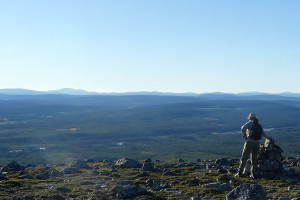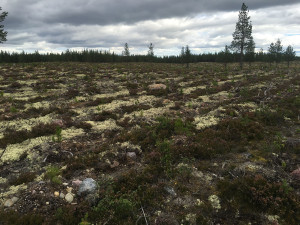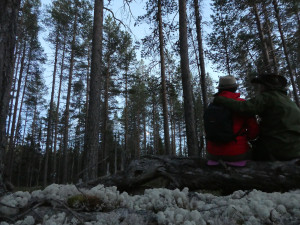The business manager is concerned

Close to the mountains - untouched forests, bogs and the occasional copse and forest plantation as far as the eye can see.
Intensive nature conservation work provided protection for mountainous forests.
The battle for the forest near the mountains began about 40 years ago. The deforestation of the productive forest land began to reach the limit of what the law allows, and the Swedish National Park Authority (now Sveaskog) began to systematically build roads in roadless land. At each end of the road, a clearance was made with the subsequent planting of pure plantations of the contorta pine, which is foreign to Sweden. The story is well told in this article from 2015.
Through intensive work, conservationists, particularly in Norrbotten, succeeded in stopping the continued deforestation of the miles of natural forests that spread just east of the mountain range. The 1979 Forestry Act sets out new rules for felling in forests that are difficult to rejuvenate and close to the mountains. In 1983, the limit for difficult to rejuvenate forests was set, and in 1991 for close to the mountains. Read about this here.
Is the pause in deforestation in the mountains over?
This marked the beginning of the break from clear-cutting for the forest near the mountains. Large areas were also formally protected and today about half of all protected forests in Sweden are close to the mountains. But as early as 2008, it was time to tinker with the protection and the limit for the hard-to-rejuvenate forest was dismantled. The forestry companies immediately cut large wounds in natural forests that had never before been subjected to clear-cutting methods.
Within 20 years, with effective planning by forestry companies, a forest owner can legally cut down at least half of all the forest they own in an area. And they are well on their way in the previously hard-to-rejuvenate forest, but now the precarious situation has become obvious that there is simply a shortage of natural forest types in Sweden.
Do you believe in miracles?
There is such a lack of natural forest in all productive forest land below the mountains that we will not be able to protect biodiversity in the long term unless forest land is restored to natural forest. The shortage is greatest in southern Sweden, and more than 10% of the already heavily cleared forest land needs to be miraculously restored to ecologically functioning natural forests with major financial investment. No one knows how to do this.
Therefore, Naturarvet the main focus has been on finding remaining old-growth forest that can be preserved in the south of the country. The small fragments that, like needles in a haystack, are difficult to root out must be protected at all costs. Yet it is difficult to get everything together to protect an area. Above all, more money is needed. And those precious pennies do not grow on trees, there are no miracle solutions to the lack of money in nature conservation. Only you and I can remedy it.
Nature conservation = climate threat?
Then, without prior consultation with interested parties, the Director General of the Swedish Forestry Agency, Herman Sundqvist, decided to pause the key biotope inventory in north-western Sweden. Nature conservation organizations met the decision with indignation, and WWF and the Swedish Society for Nature Conservation chose to discontinue their collaboration with the Swedish Forest Agency. The decision has also upset employees of the agency and a large number of researchers are now calling for the resumption of the key biotope inventory.
The forestry companies have responded with the most serious attack on nature conservation in Sweden to date.in which they have joined forces to express their intention to stop coddling the mountain forests. Using the "climate" as a bat, they call for as much forest as possible to be felled. They simply want to deregulate even the forests near the mountains.
Thus, they not only want the key biotope inventory to remain on hold. They also want to ensure that the break that the mountain forest has had from clear-cutting is ended. According to their profit-driven view, it is not profitable to protect more forest where so much is already protected. Conservationists are painted as climate villains because the forest industry believes that protecting forests at all is not compatible with the climate goal.
Then the thought strikes me...
My immediate reaction is that we must now focus on protecting the forest near the mountains, as all other nature conservation organizations have done. Then the thought strikes me - so now that we are all focusing on northwestern Sweden, the companies can continue to clear-cut the last fragments of old-growth forest and continuity forests in southern Sweden in the shadow of the great threat to mountain forests!
I have said it before and it is becoming increasingly clear that the major political and economic movement is pushing for the urgent destruction of everything that has not yet been destroyed. Using the 'climate' as an argument, the next step will be to cut down what has been protected but must be cut down to 'save the planet'. Proponents of this approach consider it an act of pure solidarity with the peoples of the world.
We must not lose our focus: Nature conservation = climate smart + species smart!
It is more important than ever, for the sake of nature, biodiversity and the climate, to invest in independent forms of protection that cannot be overturned by political decisions. The fact that old-growth forests bind carbon is proven in the few studies that have been carried out (almost no one wants to fund such research). It is undisputed that old-growth forests are vital for biodiversity and that logging is the greatest threat to it!
Naturarvet is the independent nature conservation organization in Sweden today that can guarantee permanent protection for the forests that come into the ownership of the collection foundation. Let's build a strong collection for a natural heritage of the last Swedish old-growth forests, with protection guaranteed by the Natural Heritage statutes and the foundation law.
Together with Naturarvet you are preserving Sweden's last ancient forests!

